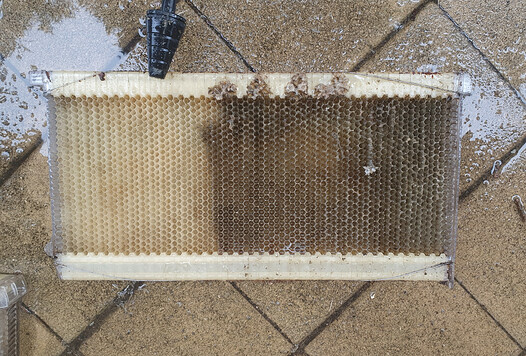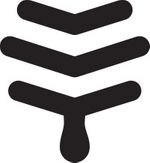Flow Frames shouldn’t need cleaning in general, if the bee colony is strong they should keep the frames clean. Bees are very hygienic insects and keep their hive very clean - in bee terms! Sometimes that can look messy to a human.
You don't need to clean Flow Frames if left within the hive, unless you detect disease in them. If you detect disease, you will need advice from experienced beekeepers on disease prevention and response for your area.
The Honey Trough at the bottom of the frame is designed so that any honey remaining after harvest can drip back into the hive for the bees to use. If the honey leak-back gap remains clear this works well; however, if the bees block it up some honey may remain in the honey trough after harvest. Clear the leak-back gap prior to harvest and inspect the honey trough. If the honey trough is dirty it can be cleaned from outside the hive using a bottle brush or something similar.
Wax moth eggs present in the wax comb can result in an infestation on frames while in storage. This is messy but will not damage the Flow Frames. To help prevent wax moth infestation seal rinsed and dried Flow Frames in plastic to avoid reinfestation, then place in a freezer overnight. This will destroy any eggs or larvae present in the wax.
Occasionally, in times of dearth or in the winter cold, your colony can shrink their numbers to the point where they aren’t using frames, especially the side frames that aren’t above the brood nest. If condensation occurs, the frames can appear to go dark or mouldy and you may wish to clean them. Also if you prefer to store your Flow Super off the hive in winter, cleaning your Flow Frames can be a measure to discourage pests like wax moths or rats. Cleaning is also useful in the unfortunate event that your bees have died, absconded, or been slimed out by hive beetles.
Cleaning Flow Frames with a Pressure Washer
With cleaning methods, we have had the most success using a pressure cleaner.
Cold water is fine to use, however warm to hot water should yield even better results. (It is important not to use water hotter than 70 C / 160 F to avoid damaging your Flow Frames).
There is no need to take the Flow Frames apart for cleaning.
It is important to do this task away from your bees, as there’s a risk that they will smell the wax and honey and start robbing behaviour. Also, any wax left on the ground afterwards becomes available to bees all around your local area, which is how pathogens are spread between hives.
With your frame still assembled, prop it against something waterproof so that the side of the frame to be cleaned is perpendicular to the ground.
Set the cells to the open position with the bottom plug removed, and slant the frame slightly towards the plug end so all water, honey and wax can run out.
Use the pressure cleaner to spray the frame from the top to the bottom of each vertical cell line. Start a good distance away and bring the nozzle closer, slightly angled until you notice the dirty wax coming away. Avoid going too close as there is a slight risk of damaging the plastic components.
When one side is clean, flip the frame around and do the other side.

Flow Frame Storage
Allow the frames to dry fully in the shade before storing them in a dark place, or returning them to your hive. Flow Frames are UV sensitive and should not be exposed to light for extended periods.
It is not necessary to clean the frames to a spotless level, as the bees won’t know the difference and will wax them up again anyway. They will also tend to recycle any wax left over on the frame after cleaning.
If you don’t have access to a pressure washer, warm water and a hard-bristled scrubbing brush can be quite effective. Again, set your frame in the open position with the plugs removed.
Please note that we do NOT recommend the use of solvents, alcohol, or caustic solutions to clean the frame.




